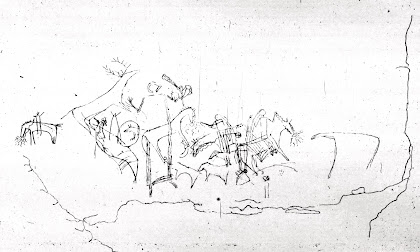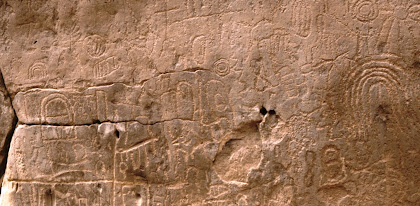This is a compilation of previous columns from RockArtBlog about sound and music at rock art sites.
ROCK ART AND SOUND EFFECTS, 24 February 2010:
Black Salon, Grotte de Niaux, Ariege, France. From Rault, 2000, p. 18.
One small but interesting subset in the study of rock art concerns the
acoustics of rock art sites. According to some researchers it is possible to
find interesting acoustics at many rock art sites. In locales where the rock
art is on cliffs they believe that the form of the cliffs often provides for a
stronger echo than other nearby sections of cliff. Measurements of the strength
of echoes from various surfaces in painted European caves suggest that this can
indeed be the case. In 2000 Lucy Rault wrote in “Musical Instruments: Craftsmanship and Tradition from
Prehistory to the Present,” that
“comparable investigations at Niaux have
similarly demonstrated that in this cave places with particularly strong echoes
also have images associated with them, some if these, significantly, mark
places where sounds linger for several seconds. We can therefore conclude that
the choice of locations for wall figures seems to have been made largely on the
basis of their acoustical value. Sometimes whole walls remain empty where the
corresponding space, however vast it may be, produces no echo. On the other
hand, places favorable for echoes are marked and painted, even if their
location made such decoration difficult to accomplish.” (Rault 2000:22).
Bison,
Grotte du Portel, Ariege,France. From: Rault, 2000, p.23.
Given the strong echoes and reverberation found in these sites
in the painted caves of Europe, we have to ask ourselves what were they echoing?
The most obvious guess would be the sound of the animal depicted on the wall.
The call of this creature might be imitated by spiritual leaders or vocally
talented members of the clan. Another possibility could be the eerie moaning
sound of a bullroarer. Regarding this, John Pfeiffer wrote in 1982 (p. 180)
that “oval bone and ivory objects with abstract designs carved on them and a
hole at one end make a high whining hum when whirled from a string, suggesting
that the sound of a bullroarer moved people in the upper Paleolithic as well as
in modern times” (Pfeiffer’s “high whining hum” would have come from a smaller
bullroarer on a short string, a larger model on a longer string could give a
much lower roaring sound). Especially in the case of a painted bison or other
animal whose vocalizations are grunting, roaring, or rumbling sounds, hearing
the sound of a bullroarer echoing and reverberating through the chamber would
have been startling to say the least.
Halo
Shelter, Val Verde County, TX., Photo: Peter Faris, 2004.
Another
effect that can often be found in caves and rock shelters is the phenomenon of
the whisper channel. When the walls are of the correct shape they will often
pass the frequencies of a soft voice smoothly to the other end of the chamber
in such a way that they are inaudible to people standing in between. I observed
this effect in a rock shelter at Val Verde county in west Texas, where I could
hear a soft conversation of people standing about 20 feet away at the other end
of the shelter but individuals standing between us could not discern their
comments.
A number of years ago, during a visit to the Grand Gallery of Horseshoe Canyon,
in Canyonlands, Utah, one visitor had lugged a tape recorder and microphone all
the way from the canyon rim to the panel and had set up his sound equipment
while he walked back and forth along the rock art panels tapping the surface of
the rock with a little hammer made of deer or elk antler. I thought at the time
that this was a pretty silly practice, but I now see that it actually may have
had some validity. Although I could not really see back then what the value
would be in having that sort of information available, it is now obvious that
it might add to the overall metadata of cultural knowledge of the people
involved, and would allow evaluations based upon a broader knowledge of their
cultural concerns, and this would benefit everyone interested in the prehistory
of humanity.
REFERENCES:
Pfeiffer, John E., 1982, The Creative Exlosion: An Inquiry into
the Origins of Art and Religion, Cornell University
Press, Ithaca, New York.
Rault, Lucy, 2000, Musical Instruments: Traditions and
Craftsmanship from Prehistory to the Present![]() , Harry N. Abrams, Inc., New York.
, Harry N. Abrams, Inc., New York.
MUSIC AT ROCK ART SITES, 28 March 2010:
On February 24, 2010, I posted
a column titled “Rock Art and Sound Effects”. In that posting I discussed the
possibility that sound effects may have enhanced the experience of viewers of
painted panels in European caves. Also, that many rock art panels are located
in places that display unusual echo effects. Another possible manifestation of
sound at rock art sites would be music. This could be music played in the
presence of rock art, and could also be music as a theme of the imagery in the
rock art.
Trois freres sanctuary, sketched by Abbe Breuel, Musee de l'Homme.
One example of music as a theme of rock art is found in the sanctuary at Le
Trois Freres, sketched by the Abbe Breuel. Often considered a shaman figure,
this therianthropic character seems to be dancing on human legs but possesses a
bison head, horns and forelimbs. Additionally, this enigmatic figure is
obviously carrying a bow and appears to be pursuing a group of bison. This has
led to previous classifications of this scene as a portrayal of hunting magic.
Les
Trois Freres, closeup of lower right. Drawn by Abbe Breuil, 1912.
In Musical Instruments, Craftsmanship and Tradition from
Prehistory to the Present,
Lucy Rault, suggested that this figure was, in fact, playing music on a musical
bow. She described the technique of playing the instrument as “the player places the string between his
lips and strikes it with a thin stick. Modifying the volume by altering the
position of his lips, and of the tongue within the mouth cavity the musician
creates different harmonics to produce a tune” (2000: 151). Rault included
a photo of a Dan musician from the Ivory Coast and pointed out the position of
the bow relative to the mouth as representative of the figure playing the bow
as an instrument.
Musical
bow, Dan, Ivory Coast. From Rault, 2000, p.151.
In
another connection between music and cave painting bone flutes have been
excavated from deposits within caves that also possess cave paintings. It is no
great stretch to imagine those flutes being played in a context of ceremonials
in front of painted panels within the cave, although we cannot by any means
prove that both the flute playing and the painted panels were involved in the
same performance.
Since
we find the concept of music played in the context of rock art panels so
interesting, we can probably assume that the prehistoric inhabitants of those
regions would like the idea as well, and, since they had all the ingredients
available – who knows?
REFERENCES:
Rault, Lucy, 2000, Musical Instruments, Craftsmanship and Tradition from
Prehistory to the Present,
Harry N. Abrams, Inc., New York.
MUSIC AT ROCK ART SITES (CONTINUED), 26 April 2010:
On March 28, 2010, I posted a
column concerning evidence of the creation of music as a subject of a painted
panel in the Sanctuary of the cave of Le Trois Freres. Additional evidence of
Paleolithic music in connection with rock art is presented by the upper
Aurignacian carved relief known as the “Venus of Laussel” cave in France. This
famous female figure is shown holding what appears to be a bison horn in her
right hand. The horn is marked with thirteen striations down the side.
"Venus of Laussel", stone relief carving, Laussel cave, France. p.41, Rault, Lucy, Musical Instruments, Craftsmanship and Tradition from Prehistory to the Present,2000.
This figure actually suggests
two possible musical implications. One, the horn might be played trumpet
fashion. In Musical Instruments, Craftsmanship and Tradition from Prehistory to
the Present, Lucy Rault (2000) provided pictures of tribal people playing
animal horns trumpet fashion. In playing a trumpet the sound is provided by
vibration of the player’s lips blown into the mouthpiece, in these examples a
hole drilled into the side of the horn down near the pointed end. Although the
Venus of Laussel does not have the horn held to her mouth we must allow the
possibility.
Side-blown Kudu horn, Chad. p.198, Rault, Lucy,Musical Instruments, Craftsmanship and Traditionfrom Prehistory to the Present, 2000.
Another possibility relates to the thirteen striations on the
side of the horn. With these it is possible that the horn was played as a
rhythm instrument known as a rasp. The Ute Indians of Colorado and Utah use a
rasp called a morache for their annual Bear Dance in which a notched stick or
bone (reportedly originally a bear jaw bone) is held against a resonator such
as a basket, a drum, or a plank over a hole in the ground, and rubbed with a
stick. The rubbing of the stick back and forth over the notches provides the
vibration of the instrument. The sound was felt to reproduce the growling of
the bear. Back in 1980 my wife and I attended the spring Bear Dance at Ignacio
in the Ute Mountain Ute reservation in southwestern Colorado. The continuing
low drone of the morache is immensely compelling and quickly begins to resonate
in the mind of the listeners. Rault points out that with the striations marked
on the side of the horn held by the “Venus of Laussel” it could have been
played as a rasp, rubbed with a stick like the Ute morache and the conical form
of the horn would also provide the resonating chamber. Perhaps this sound
echoing within the cave would provide a roaring or growling sound to emulate
one of the great animals painted on the cave walls.
Stalactites as lithophone, South Africa.
p.25, Rault, Lucy,
Musical
Instruments, Craftsmanship and Tradition
from
Prehistory to the Present, 2000.
Another interesting possibility for music played within a cave
is provided by the presence of stalactite and stalagmite formations which can
be played as a percussion instrument. Such a formation used to make music is
known as a lithophone, a stone instrument. Rault stated that in some of the
painted caves of Europe evidence remains as signs of impact on such stalactite
and stalagmite formations that would ring like a xylophone when struck with a
wooden, bone, or perhaps an antler hammer.
As I stated in my previous column none of this is proof that there was ever any
playing of music in company with rock art painted on the cave walls. We must,
however, acknowledge that it could have been, and I prefer to assume that on
ceremonial occasions music and other sound effects would have been included in
at least some of the ceremonies.
REFERENCE:
Rault, Lucy, 2000, Musical Instruments, Craftsmanship and
Tradition from Prehistory to the Present,
Harry N. Abrams, Inc., New York.















%20-%20Copy.jpg)



























